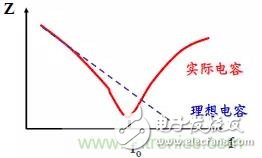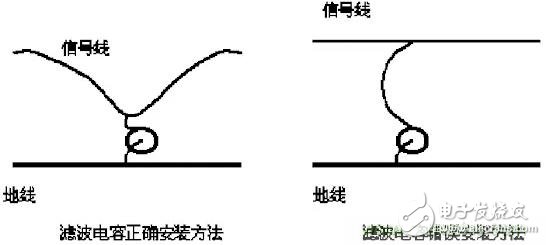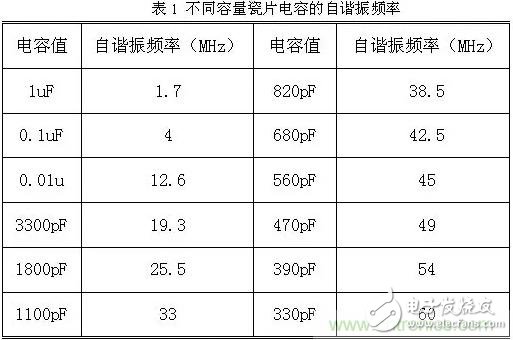Capacitors are one of the most basic components in a circuit. The use of capacitors to filter high frequency disturbances on circuits and decoupling power supplies is familiar to all circuit designers. However, as the problem of electromagnetic interference becomes more and more prominent, especially the increasing frequency of interference, it is sometimes the case that the expected filtering effect is not achieved because the basic characteristics of the capacitor are not understood. Some of the things to be aware of when using capacitors to suppress electromagnetic interference are described below.
The capacitor is the basic filter used as a bypass device in the low pass filter. By utilizing its characteristic that the impedance decreases with increasing frequency, it acts as a bypass for high frequency interference. However, in actual use, we must pay attention to the non-ideality of the capacitor.
(1) The equivalent circuit of the actual capacitor
The circuit model of the actual capacitor is shown in Figure 1. It is a series network consisting of equivalent inductance (ESL), capacitance and equivalent resistance (ESR). The inductance component is determined by the lead and capacitor structure, which is inherent to the dielectric material. The inductance component is the main indicator affecting the frequency characteristics of the capacitor. Therefore, when analyzing the bypass function of the actual capacitor, it is equivalent to the LC series network.
(2) Effect on filter characteristics
The characteristics of the actual capacitor are shown in Figure 2. When the angular frequency is 1/LC, series resonance occurs. At this time, the impedance of the capacitor is the smallest and the bypass effect is the best. After the resonance point is exceeded, the impedance characteristic of the capacitor exhibits the characteristic of the inductive impedance - as the frequency increases, the bypass effect begins to deteriorate. This is because the capacitor used as a bypass device begins to lose its bypass function.
Figure 2. Frequency characteristics of the actual capacitor
The impedance of the ideal capacitor decreases as the frequency increases, while the impedance of the actual capacitor has a frequency characteristic as shown in Figure 2. At a lower frequency, it exhibits a capacitive property, that is, the impedance decreases with increasing frequency, at some Resonance occurs at one point, at which point the impedance of the capacitor is equal to the equivalent series resistance ESR. Above the resonance point, due to the action of ESL, the capacitance of the capacitor increases with increasing frequency, which is the impedance characteristic of the capacitor exhibiting inductance. Above the resonance point, since the impedance of the capacitor increases, the bypass effect on the high frequency noise is weakened or even disappeared.
The resonant frequency of the capacitor is determined by the combination of ESL and C. The larger the capacitance or inductance value, the lower the resonant frequency, that is, the high frequency filtering effect of the capacitor is poor. In addition to the type of capacitor, the length of the lead of the capacitor is a very important parameter. The longer the lead, the larger the inductance and the lower the resonant frequency of the capacitor. Therefore, in actual engineering, the lead of the capacitor should be as short as possible, and the correct installation method and incorrect installation method of the capacitor are shown in Fig. 3.
According to the principle of LC circuit series connection, the resonance point is not only related to the inductance, but also related to the capacitance value. The larger the capacitance, the lower the resonance point. Many people think that the larger the capacitance of the capacitor, the better the filtering effect, which is a misunderstanding. The larger the capacitance is, the better the effect on low-frequency interference is. However, since the capacitance resonates at a lower frequency, the impedance starts to increase with the increase of the frequency, so the bypass effect on the high-frequency noise is deteriorated. Table 1 shows the self-resonant frequencies of ceramic capacitors of different capacities, and the lead length of the capacitor is 1.6 mm.
Figure 3. Correct installation method and incorrect installation method of filter capacitor
Although capacitive resonance is not desired from the viewpoint of filtering out high frequency noise, the resonance of the capacitor is not always harmful. When the noise frequency to be filtered is determined, the capacitance can be adjusted to make the resonance point just fall on the disturbance frequency.
Capacitors used in EMC design require the resonant frequency to be as high as possible in order to be effective in filtering over a wide frequency range. There are two ways to increase the resonant frequency. One is to shorten the length of the lead as much as possible, and the other is to use a type with a smaller inductance.
The capacitor is the basic filter used as a bypass device in the low pass filter. By utilizing its characteristic that the impedance decreases with increasing frequency, it acts as a bypass for high frequency interference. However, in actual use, we must pay attention to the non-ideality of the capacitor.
(1) The equivalent circuit of the actual capacitor
The circuit model of the actual capacitor is shown in Figure 1. It is a series network consisting of equivalent inductance (ESL), capacitance and equivalent resistance (ESR). The inductance component is determined by the lead and capacitor structure, which is inherent to the dielectric material. The inductance component is the main indicator affecting the frequency characteristics of the capacitor. Therefore, when analyzing the bypass function of the actual capacitor, it is equivalent to the LC series network.
Figure 1, the equivalent circuit of the actual capacitor
(2) Effect on filter characteristics
The characteristics of the actual capacitor are shown in Figure 2. When the angular frequency is 1/LC, series resonance occurs. At this time, the impedance of the capacitor is the smallest and the bypass effect is the best. After the resonance point is exceeded, the impedance characteristic of the capacitor exhibits the characteristic of the inductive impedance - as the frequency increases, the bypass effect begins to deteriorate. This is because the capacitor used as a bypass device begins to lose its bypass function.

Figure 2. Frequency characteristics of the actual capacitor
The impedance of the ideal capacitor decreases as the frequency increases, while the impedance of the actual capacitor has a frequency characteristic as shown in Figure 2. At a lower frequency, it exhibits a capacitive property, that is, the impedance decreases with increasing frequency, at some Resonance occurs at one point, at which point the impedance of the capacitor is equal to the equivalent series resistance ESR. Above the resonance point, due to the action of ESL, the capacitance of the capacitor increases with increasing frequency, which is the impedance characteristic of the capacitor exhibiting inductance. Above the resonance point, since the impedance of the capacitor increases, the bypass effect on the high frequency noise is weakened or even disappeared.
The resonant frequency of the capacitor is determined by the combination of ESL and C. The larger the capacitance or inductance value, the lower the resonant frequency, that is, the high frequency filtering effect of the capacitor is poor. In addition to the type of capacitor, the length of the lead of the capacitor is a very important parameter. The longer the lead, the larger the inductance and the lower the resonant frequency of the capacitor. Therefore, in actual engineering, the lead of the capacitor should be as short as possible, and the correct installation method and incorrect installation method of the capacitor are shown in Fig. 3.
According to the principle of LC circuit series connection, the resonance point is not only related to the inductance, but also related to the capacitance value. The larger the capacitance, the lower the resonance point. Many people think that the larger the capacitance of the capacitor, the better the filtering effect, which is a misunderstanding. The larger the capacitance is, the better the effect on low-frequency interference is. However, since the capacitance resonates at a lower frequency, the impedance starts to increase with the increase of the frequency, so the bypass effect on the high-frequency noise is deteriorated. Table 1 shows the self-resonant frequencies of ceramic capacitors of different capacities, and the lead length of the capacitor is 1.6 mm.

Figure 3. Correct installation method and incorrect installation method of filter capacitor

Although capacitive resonance is not desired from the viewpoint of filtering out high frequency noise, the resonance of the capacitor is not always harmful. When the noise frequency to be filtered is determined, the capacitance can be adjusted to make the resonance point just fall on the disturbance frequency.
Capacitors used in EMC design require the resonant frequency to be as high as possible in order to be effective in filtering over a wide frequency range. There are two ways to increase the resonant frequency. One is to shorten the length of the lead as much as possible, and the other is to use a type with a smaller inductance.
Car Tire Pressure Gauge,Analog Pressure Gauge,Exhaust Back Pressure Gauge,Copper Tube Manometer
ZHOUSHAN JIAERLING METER CO.,LTD , https://www.zsjrlmeter.com